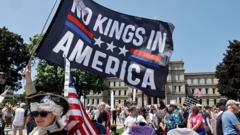In a wave of nationwide protests dubbed "No Kings," demonstrators took to the streets across the United States in response to President Donald Trump’s military parade held in Washington, D.C. on his birthday. Organized as a counteraction to the parade celebrating the 250th anniversary of the US Army, these protests were sparked by recent unrest regarding Trump’s immigration policies.
Crowds of protesters gathered in major cities like New York, Houston, and Philadelphia, wielding flags and placards condemning Trump’s administration. Karen Van Trieste, a protester in Philadelphia, voiced her concerns, stating, “I just feel like we need to defend our democracy,” emphasizing her opposition to cuts in public health agencies due to Trump’s policies.
The Los Angeles protests became particularly notable, with residents expressing anger over recent deportation raids. Tensions escalated as National Guard troops, deployed against the wishes of local officials, met hardened demonstrators. Jose Azetcla, a civil rights activist, highlighted the human cost of these policies, arguing, “You don’t separate families.” Despite instances of violence, peaceful protests continued in various areas.
Remarkably, despite this demonstration against Trump, recent polls suggest a substantial portion of the public still supports his immigration agenda, with 54% statistics approving of deportation efforts for undocumented immigrants. Critics labeled the military event a lavish exercise in vanity, with costs reported between $25 million and $45 million.
While the parade drew mixed reactions — some attendees defended it as a tribute to the military, recalling the significance such events have for veterans — others expressed concern over the militarization and political implications of soldiers marching during a time of civil unrest. As protests rumbled across the country, the atmosphere remained charged with both patriotism and dissent.
Crowds of protesters gathered in major cities like New York, Houston, and Philadelphia, wielding flags and placards condemning Trump’s administration. Karen Van Trieste, a protester in Philadelphia, voiced her concerns, stating, “I just feel like we need to defend our democracy,” emphasizing her opposition to cuts in public health agencies due to Trump’s policies.
The Los Angeles protests became particularly notable, with residents expressing anger over recent deportation raids. Tensions escalated as National Guard troops, deployed against the wishes of local officials, met hardened demonstrators. Jose Azetcla, a civil rights activist, highlighted the human cost of these policies, arguing, “You don’t separate families.” Despite instances of violence, peaceful protests continued in various areas.
Remarkably, despite this demonstration against Trump, recent polls suggest a substantial portion of the public still supports his immigration agenda, with 54% statistics approving of deportation efforts for undocumented immigrants. Critics labeled the military event a lavish exercise in vanity, with costs reported between $25 million and $45 million.
While the parade drew mixed reactions — some attendees defended it as a tribute to the military, recalling the significance such events have for veterans — others expressed concern over the militarization and political implications of soldiers marching during a time of civil unrest. As protests rumbled across the country, the atmosphere remained charged with both patriotism and dissent.





















